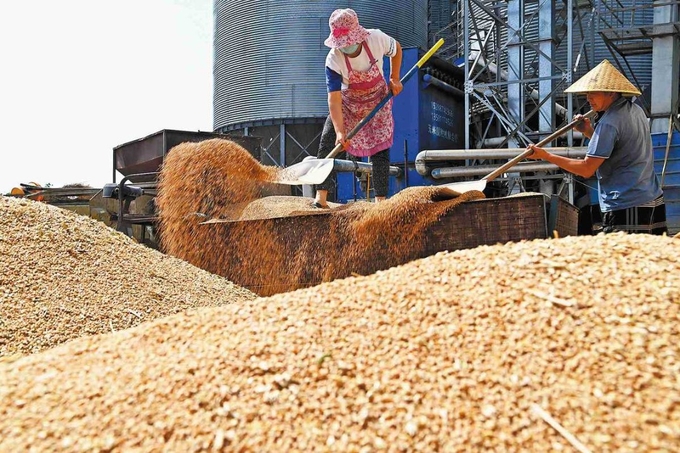June 25, 2025 | 16:31 GMT +7
June 25, 2025 | 16:31 GMT +7
Hotline: 0913.378.918
June 25, 2025 | 16:31 GMT +7
Hotline: 0913.378.918

Photo: Chinadaily.
The operations can help reduce losses during summer grain harvesting, enhance food security capabilities and ensure that every grain can come to warehouses for storage, said Bi Lianjun, director of State-owned Juye Grain Reserve.
Bi noted that through technological optimization and management innovation, efficiency has been improved in the grain harvest chain, promoting an increase in grain production and contributing significantly to the stable supply of grain in the county.
In 2023, the total grain output of Shandong reached 56.55 million metric tons, a record high and ranking third in the country, Bi said, adding that back in 1949, the province's total grain output was only 8.7 million tons.
Wang Jingdong, deputy director of Shandong Provincial Department of Agriculture and Rural Affairs, said that in the first half of this year, the province's total grain output reached 27.17 million tons, a rise of 1.6 percent year-on-year.
Bi noted that the arrangement at Juye Grain Reserve, which emphasizes that every step of the operation must be strictly controlled, including grain sampling, moisture content, bulk density, impurities, imperfect grains and hygiene indicators, clearly showed the high-tech operations there.
Early in the morning, the reserve is bustling with vehicles transporting grain. As the vehicle enters the warehouse, the inspection of grain quality immediately starts.
After passing the initial inspection, wheat needs to undergo a series of precision instruments for retesting to ensure accuracy before it can be stored, Bi said.
In order to cope with the possible impact of adverse weather, such as rains, on grain quality, Juye Grain Reserve warehouses have conducted equipment debugging and operation in advance to ensure that all equipment works normally.
In recent years, the warehouse has continuously introduced and applied advanced grain storage technologies, such as electronic temperature measurement, mechanical ventilation, circulation fumigation and inner loop flow control temperature, achieving scientific grain storage, green grain storage and intelligent management, Bi said.
At present, the storage capacity of the reserve warehouses has reached 110,000 tons, with an average daily storage volume of over 2,000 tons, Bi said.
In order to better respond to the national call, the Juye Grain Reserve Bank has planned sufficient storage capacity and funds for grain in advance.
Juye county has invested 14 million yuan ($1.97 million) building two new warehouses. Upon completion, the storage capacity at Juye Grain Reserve will reach 150,000 tons, becoming one of the largest individual warehouses in Heze, Bi said.
(Chinadaily)

(VAN) The Net Zero door is opening, but no one can walk through it if they stay outside the mandatory emissions inventory roadmap starting in 2025.

(VAN) The visit to China Agricultural University opens up new prospects for high-tech agricultural cooperation, fostering connections between research institutes and enterprises of Vietnam - China.

(VAN) Con Dao, the emerald gem in the vast ocean, is undergoing a powerful revival, transforming into one of Vietnam’s leading ‘eco-spiritual paradises.’ In this journey.

(VAN) UNDP in Vietnam organized a consultative workshop to discuss ways to integrate detailed implementation plans into the national food systems transformation strategy.

(VAN) Waznet helps digitize waste collection data, recognizing the environmental contributions of informal collectors in reducing greenhouse gas emissions.

(VAN) All parties have acknowledged the barriers in mobilizing finance for conservation, proposing detailed initiatives. One of the most effective methods is to employ natural-based solutions.

(VAN) Vietnam is the country with the highest diversity of primate species in Southeast Asia, but most of them are seriously threatened, creating an urgent need for conservation efforts.